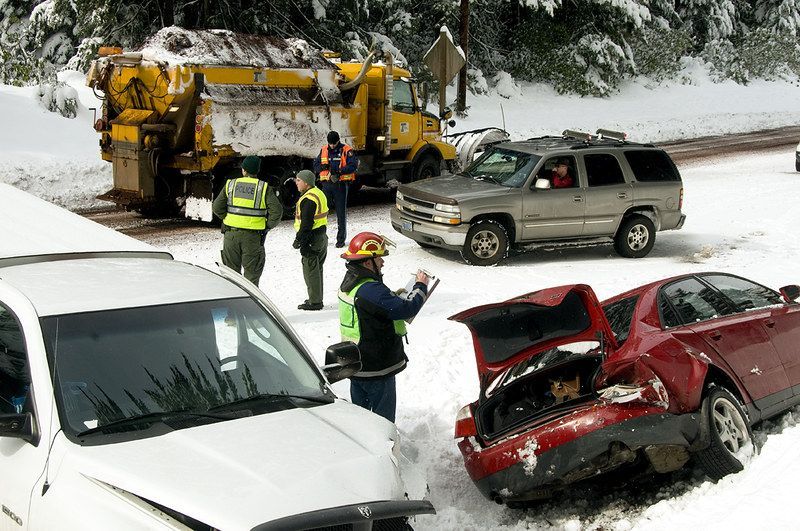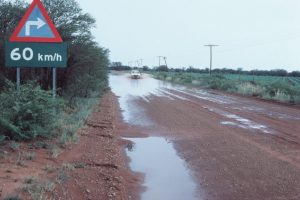 Courtesy of Oregon DOT, Flickr, CC BY 2.0
Courtesy of Oregon DOT, Flickr, CC BY 2.0Effective emergency management applies a comprehensive approach to build and sustain capabilities that reduce vulnerabilities and better manage emergency events. The phases of emergency management form a continuous process to manage risks and hazards and to reduce the impacts on the transportation system.
Transportation’s unique role in emergency management stems from the broad range of capabilities and responsibilities of state departments of transportation (DOTs). Roadways provide evacuation routes. Signs can alert and deter. Vehicles can move people out of danger. All state DOTs deal with incidents at varying scales on a daily basis. Some flip the switch from everyday operations to emergency operations a dozen times a year or more. For others, emergency activation is rare. An effective emergency management program is both a routine business requirement and a strategic, enterprise-wide risk management responsibility.
Emergency management is challenging because events are uncommon and unpredictable. Guidance on state DOT emergency management is available in several recent National Cooperative Highway Research Program (NCHRP) research reports. NCHRP Research Report 931: A Guide to Emergency Management at Transportation Agencies, published in 2020, addresses where state DOTs fit into and what they offer the traditional emergency management community. NCHRP Research Report 1093: An Emergency Management Playbook for State Transportation Agencies and NCHRP Research Report 1088: State DOT Models for Organizing and Operating Emergency Response: A Guide, published in 2024 and 2023, respectively, cover how transportation agencies are structured and who they deploy to respond to a range of emergencies.
Emergency Management Playbook
The playbook is an actionable guide to help state DOTs improve their full emergency preparedness program, based on effective approaches from agency experiences. It provides guidance on ways to work smart and ideas on how to address gaps, contingencies, or new hazards.
The playbook gives an overview of the essential elements of an agency emergency management program and functions, identifying major roles, responsibilities, and resources. Common essentials include the following:
- Overall structure and resources to support emergency management operations
- Policy setting that supports state and agency policies and needs
- Deployment, coordination, and management of emergency personnel and resources
- Ability to address types and levels of emergencies
- Employee training
- Chain of command and delegation of authority
The playbook also includes approaches to address common challenges, build an emergency management culture, and sustain success.
Much of the playbook is dedicated to key capabilities and activities—or plays—by event and mission: preparedness, protection and mitigation, and response and recovery. While no playbook can address all events, it has been estimated that 80 percent of an emergency management program is generic and applies to all hazards. Another 15 percent is specific to the type of hazard, with the remaining 5 percent unique to the particular event (1).
Resources in the playbook include key questions to ask before, during, and after an emergency event, overviews of damage assessment, communication, and other available tools, and an emergency management capability self-assessment tool. It also contains a state DOT-specific guide to the interstate Emergency Management Assistance Compact —a national mutual aid system that enables states to request help or each other through their respective emergency management agencies.
Organizational and Operational Models
How an agency organizes to effectively surge from everyday operations to emergency mode and back again varies from state to state, as well as by event type and event significance. However, there are common themes and models. NCHRP Research Report 1088 provides a framework, examples of governance and staffing structures, and case examples for examining the pros and cons of discrete aspects of various organizational approaches.
The guide presents categories and issues that are important to consider when determining emergency management budgets for personnel, equipment, and activities, and where emergency management functions should be placed within the organizational structure. Rather than offering prescriptive reporting and staffing methods, the framework provides a range of options and considerations for pursuing them.
The guide identifies organizational and operational models for state DOT emergency management and response across three broad functions: governance, programmatic and planning support, and response. Within these three functions, subcategories present a range of viable options, with pros and cons, state DOT examples, and keys for success. State DOTs are invited to reflect on what works well for them and their community and whether adjusting some organizational functions might be worth considering.
Six case examples delve deeper into the following topics of interest to state DOTs:
- Emergency response specialized strike teams
- Evolution of a state DOT emergency management program
- Financial aspects of emergency management
- Security and emergency management
- Transportation System Management Operations with emergency management
Conclusions
Action steps for effective emergency management, as outlined in a pocket guide accompanying NCHRP Research Report 1093, include the following:
- Be intentional about emergency management. Establish an overall structure to support emergency management. Document processes and capture lessons learned during events to make improvements.
- Be prepared to scale up a response. Establish triggers for activation in advance and clarify who does what.
- Institutionalize emergency management. Bolster relationships year-round and document agreements. Establish emergency management training and cross-training requirements. Identify emergency management performance measures.
Recognizing that transportation agencies have different structures and approaches for emergencies, the information in the playbook and organizational and operational models guide should enable all agencies to review and improve their current emergency management programs and address evolving hazards.





